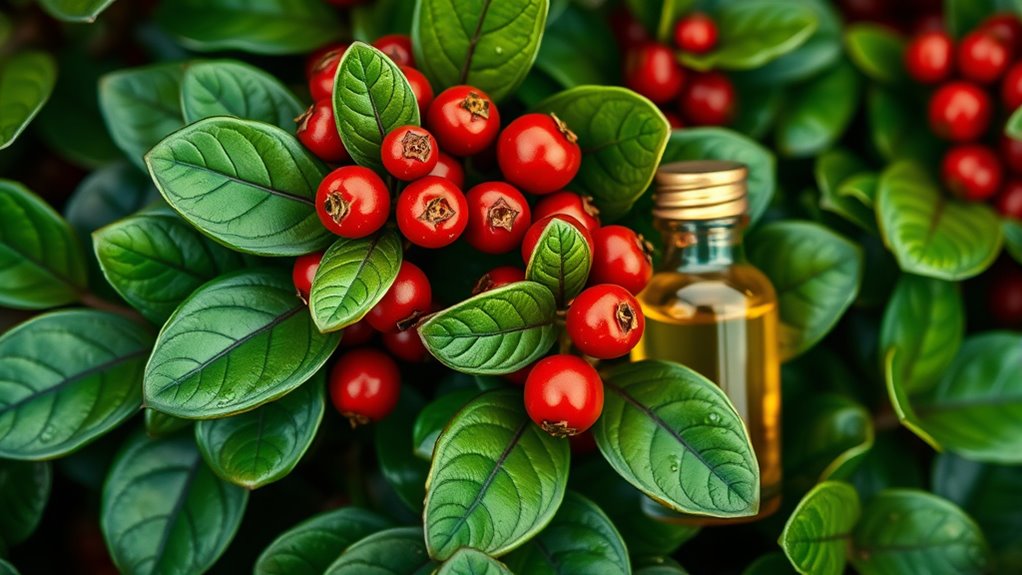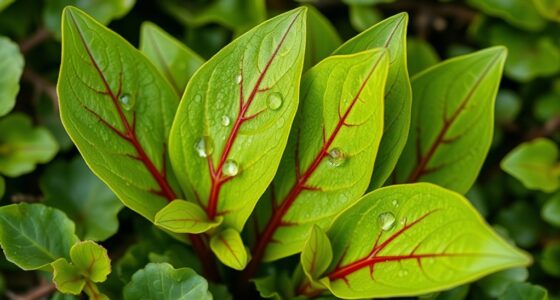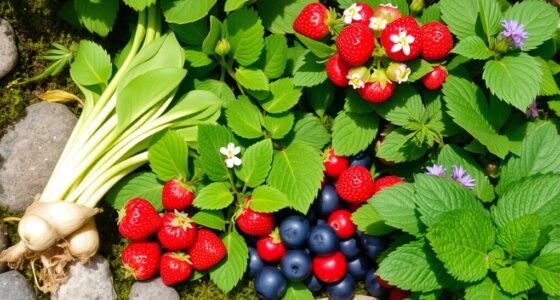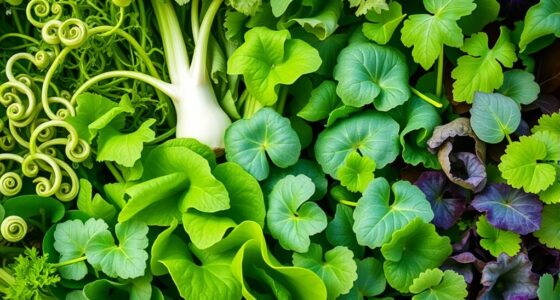Wintergreen, or teaberry, features aromatic leaves, vibrant red berries, and essential oil from Gaultheria that deliver natural healing, invigorating scents, and a strong connection to nature’s power. The leaves can be brewed into teas for medicinal benefits, while the berries add flavor and vitality. The essential oil, rich in methyl salicylate, soothes muscles and reduces inflammation. Discover how these elements embody the plant’s healing potential and natural energy as you explore further.
Key Takeaways
- Wintergreen, or Teaberry, belongs to the Gaultheria genus, known for aromatic leaves, red berries, and essential oil.
- The leaves are used in teas and infusions for their medicinal properties, including pain relief and anti-inflammatory effects.
- The berries are sweet-tart, visually appealing, and symbolize vitality and natural energy.
- The essential oil, rich in methyl salicylate, is used to soothe muscles and joints naturally.
- Wintergreen’s invigorating mint-like aroma promotes mental clarity and connection to nature’s healing power.

Wintergreen, also known as teaberry, is a versatile plant celebrated for its aromatic leaves, vibrant red berries, and essential oil. This plant isn’t just beautiful; it’s a symbol of natural freedom, offering you a way to reconnect with nature’s raw power. Its aroma profiles burst with invigorating freshness, a sharp mint-like scent that awakens your senses and clears mental clutter. When you breathe in the aroma of wintergreen, you’re embracing a scent that’s both soothing and energizing, a reminder that true liberation comes from tapping into nature’s simplest, most potent gifts. The medicinal uses of wintergreen are as diverse as its aroma. Historically, it’s been used to relieve pain, reduce inflammation, and boost circulation, making it a natural alternative to synthetic remedies that often leave you feeling trapped in dependency. The essential oil derived from its leaves contains methyl salicylate, a compound that acts quickly to soothe sore muscles and joints, giving you the power to move freely without pain holding you back. Its medicinal properties aren’t just about alleviating discomfort—they’re about reclaiming your well-being from the confines of pharmaceutical dependency. When you incorporate wintergreen into your routine, you’re making a conscious choice for natural healing that respects your body’s innate ability to recover and thrive. The aromatic leaves can be used in teas or infusions, allowing you to harness their medicinal benefits while immersing yourself in their invigorating scent. This plant invites you to break free from the limitations imposed by modern medicines and rediscover the healing potential of nature, a true act of liberation. The berries add a visual and gustatory delight, offering a sweet-tart flavor that complements the bold aroma and reinforces your connection to the plant’s natural vitality. By understanding and utilizing wintergreen’s aroma profiles and medicinal uses, you empower yourself to take control of your health in a way that’s rooted in authenticity and freedom. It’s an invitation to harness the plant’s natural energy, to breathe deeply, and to feel the liberation that comes from aligning with nature’s purest remedies. Wintergreen isn’t just a plant; it’s a symbol of independence, a fragrant reminder that healing and wellness are within your reach when you choose to embrace the gifts of the natural world.
Frequently Asked Questions
Is Wintergreen Safe for Children and Pregnant Women?
Wintergreen isn’t typically safe for children and pregnant women. You should prioritize children safety and pregnancy precautions by avoiding this oil, as it contains methyl salicylate, which can be toxic in high doses. For a safe, natural approach, consider alternatives. Always consult a healthcare professional before using wintergreen products during pregnancy or around young children, so you can enjoy relief without risking health.
How Can I Identify Genuine Wintergreen Oil From Counterfeit Products?
Identifying genuine wintergreen oil is like finding a needle in a haystack—focus on quality assurance and adulteration detection. Check for a strong, minty aroma that’s pure and consistent, not diluted or synthetic. Look for labels indicating 100% pure oil from Gaultheria procumbens, and buy from trusted suppliers with transparent sourcing. Avoid products with artificial scents or unclear ingredients—your liberation lies in trusting authentic, unadulterated wintergreen oil.
Are There Any Known Allergic Reactions to Wintergreen Leaves or Berries?
You might experience allergic dermatitis or skin sensitivity from wintergreen leaves or berries. If you notice redness, itching, or irritation after contact, stop using them immediately. While many enjoy their benefits, some people are more prone to allergic reactions. To stay liberated from discomfort, do a patch test first, and consult a healthcare professional if you have a known sensitivity or experience adverse symptoms.
What Are Traditional Medicinal Uses of Wintergreen in Different Cultures?
You uncover that wintergreen’s traditional remedies span cultures—used for pain relief, fevers, and respiratory issues. In indigenous practices, leaves and berries serve as healing tools, revealing deep-rooted cultural practices. In Europe, the oil’s invigorating scent symbolizes energy. Embrace this knowledge, and you’re empowered to explore natural healing, breaking free from conventional limits. Let wintergreen’s rich history inspire your journey toward holistic wellness and personal liberation.
How Does Wintergreen Oil Affect Pets if Ingested or Applied?
You should know that wintergreen oil can be toxic to pets if ingested or applied improperly. Its potent compounds, like methyl salicylate, pose serious pet toxicity risks, including gastrointestinal issues and neurological problems. To guarantee safety, always follow essential oil safety guidelines and keep wintergreen oil out of your pets’ reach. Avoid using it around animals unless advised by a veterinarian, because their health and well-being come first.
Conclusion
As you hold wintergreen’s leaves, berries, and oil in your hands, imagine a whisper of minty freshness swirling through a winter forest. This tiny treasure packs a punch of invigorating aroma, like a cool breeze dancing over snow-covered pines. Whether you’re brewing tea or exploring its natural wonders, wintergreen’s essence invites you to embrace the crisp, invigorating spirit of winter’s quiet magic—an evergreen secret waiting to awaken your senses.










